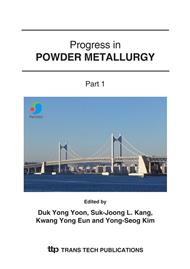p.913
p.917
p.921
p.925
p.929
p.933
p.937
p.941
p.945
Studies on Preparation of Ti3SiC2 Particulate Reinforced Cu Matrix Composite by Warm Compaction and Its Tribological Behavior
Abstract:
Conventional powder metallurgy processing can produce copper green compacts with density less than 8.3 g/cm3 (a relative density of 93%). Performances of these conventionally compacted materials are substantially lower than their full density counterparts. Warm compaction, which is a simple and economical forming process to prepare high density powder metallurgy parts or materials, was employed to develop a Ti3SiC2 particulate reinforced copper matrix composite with high density, high electrical conductivity and high strength. In order to clarify the warm compaction behaviors of copper powder and to optimize the warm compaction parameters, effects of lubricant concentration and compaction pressure on the green density of the copper compacts were studied. Copper compact with a green density of 8.57 g/cm3 can be obtained by compacting Cu powder with a pressure of 700 MPa at 145°C. After sintered at 1000°C under cracked ammonia atmosphere for 60 minutes, density of the sintered compact reached 8.83 g/cm3 (a relative density of 98.6%). Based on these fabrication parameters a Ti3SiC2 particulate reinforced copper matrix composite was prepared. Its density, electrical conductivity, ultimate tensile strength, elongation percentage and tribological behaviors were studied.
Info:
Periodical:
Pages:
929-932
Citation:
Online since:
January 2007
Authors:
Price:
Сopyright:
© 2007 Trans Tech Publications Ltd. All Rights Reserved
Share:
Citation:


